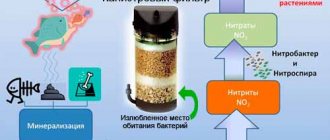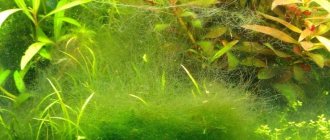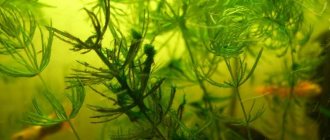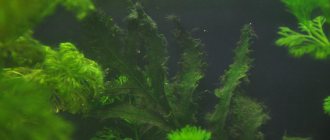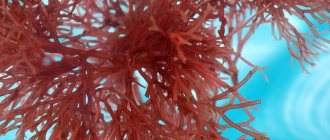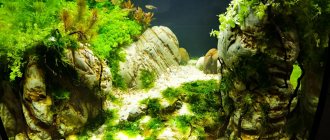Beginning aquarists call all plants that can be found in an aquarium algae. However, experienced aquarists will never confuse algae and aquarium plants. It costs them too much to control algae to make such a mistake. What's the difference, you ask? Algae are lower plants, without roots, leaves, or shoots. They grow quickly, aggressively and with their appearance significantly worsen the appearance of the aquarium, covering the walls and aquarium plants. Algae grows in aquariums, in salt water and in fresh water, and this means that the aquarium is alive. For an aquarist, the growth of algae is only a sign that something is wrong in the aquarium.
All aquariums have algae on sand and gravel, rocks and plants, walls and equipment. They are completely natural and part of the normal balance, unless they grow rapidly.
All that is required for a balanced aquarium is clear, well-mixed water and clean glass. I even advise not to clean all the walls of the aquarium, leaving the back one covered with fouling.
I have noticed that when algae is left to grow on the back wall or rocks, it absorbs nitrates and other waste products, thereby reducing the opportunities for algae to grow on the front and side walls of the aquarium. In addition, many catfish eat them (for example, Ancistrus).
Many aquarium inhabitants feed intensively on surfaces overgrown with algae. The cichlids of Lake Malawi are widely known as fish adapted to feeding on algae.
Examples of the type, pseudotropheus, are very characteristic. These fish have hard teeth that allow them to tear algae from rocks. Mollies look for clearings of algae and pluck them. In the marine environment, algae are an important part of the diet of sea urchins, sea worms and chitons.
For example, algae of the genus Aufwuchs (from German - growing on something), grow on hard substrates such as rocks, in both fresh and salt water. Algae, especially green algae and diatoms, are the main habitat for small crustaceans, rotifers, and protozoan life forms.
I stimulated algae growth in my cichlid to create a natural environment and got the right amount of filamentous algae and diatoms. Thus, depending on the fish species and habitat habitat, growing algae may even be desirable.
However, they often begin to multiply rapidly and worsen both the appearance and condition of the plants. And here begins the fight against algae, a phase that is familiar to many aquarists, especially those who prefer aquariums with plants.
What is algae
Many beginning aquarists classify all aquarium vegetation as algae. This idea is wrong. The plants growing in the aquarium are the highest representatives of the plant kingdom: ferns, mosses and herbs. Algae (algal flora) include lower forms of life.
This is a large heterogeneous group that unites unicellular, multicellular and colonial forms of living organisms that live primarily in the aquatic environment. Not all of them are plants.
They do not appear out of nowhere, but fall into the container along with water, new animals, plant samples, food, stones, and snags. In addition, spores of common varieties are always present in the air.
Algae in an aquarium can cause plant death.
Under favorable conditions, their active growth begins, resulting in:
- the aesthetic appeal of the aquarium is impaired;
- plaque forms on the inner surface of the walls, the water becomes cloudy, green or yellow;
- an unpleasant odor appears;
- the filter becomes clogged;
- Plants and fish die.
Algal expansion indicates low water quality and an imbalance in the biocenosis.
There are also useful species that are biofilters, substrates for spawning and viviparity, and shelter for fry. Some macroalgae are used in aquascaping.
How to get rid of algae in an aquarium?
I will say right away that the fight against algae in an aquarium is full of controversy, contradictions, absurdities and even harm. My experience with different aquarists often led to opposing advice. There are probably many errors in this article, but I do not presume to say otherwise. Never rely on one source, never listen to one doctor, double-check the facts, think for yourself.
In a well-balanced aquarium, abundantly overgrown with plants, the balance of substances is in equilibrium; the excess is consumed by plants and algae. And since higher plants always consume more nutrients than algae, the growth of the latter is limited.
It only often happens that the balance is upset and then the algae take over. Since each type of algae has its own characteristics and conditions for rapid development, methods of combating them will be described for each species separately.
Varieties of aquarium algae
There are tens of thousands of varieties of algae.
Common aquarium species:
- diatoms;
- brown;
- green;
- red (crimson);
- blue-green (cyanobacteria).
The choice of an effective way to control algae in an aquarium depends on whether it belongs to one of these taxonomic groups.
Most often, diatoms form in poorly lit aquariums and infect plants.
Diatoms
They are microscopic single-celled organisms covered with a silicon shell. Sometimes they unite in colonies. Capable of secreting mucus. Most often they attach to various surfaces, forming dark green, yellowish or brown speckled growths that merge into larger formations. Often found in new aquariums. They develop well in low light conditions.
Getting rid of diatoms can be difficult. It is necessary to improve illumination, maintain the temperature at +25°C, change water, clean surfaces, regulate the level of silicates (remove decorative stones, use a special filter).
Brown
Brown algae in an aquarium on plants.
They are often confused with diatoms, although they represent a separate class. These are flagellated organisms, one of the stages of development of which is a multicellular form. They live mainly in the seas, but there are several freshwater species. Their color is determined by a brown pigment substance that overlaps other pigments.
They are found infrequently, mainly in young aquatic communities. They form a brown slimy coating on glass, stones, driftwood, decorative elements, and plants. Incorrect selection of lighting can stimulate their development. Plaque is removed mechanically and with the help of live cleaners.
Greens
This division of lower plants includes both unicellular and multicellular organisms. A distinctive feature is the presence of chlorophyll, which provides the green color of cells. Most representatives lead an attached lifestyle only at the beginning of development, then they develop in the water column.
They appear in the form of point formations, a green film on the walls or bottom, threads, balls. The optimal conditions for their development are elevated temperatures, long daylight hours, and an abundance of carbon dioxide, phosphates and nitrates.
Blue-green
These are bacterial organisms capable of photosynthesis. The department of cyanobacteria includes unicellular, colonial, and filamentous forms. Their color varies from greenish to deep blue. They form a slippery green coating on glass, soil, plants, are the main cause of water blooms, emit a characteristic unpleasant odor, and alkalize the aquatic environment. Some species produce toxins.
Blue-green algae are formed due to general contamination of the water in the aquarium and excess lighting.
Active growth of organisms is caused by various reasons:
- Excess organic matter due to overfeeding fish.
- pH level 7.5-9.5.
- Insufficient aeration.
- Intense lighting.
- Increase in water temperature.
- Excess phosphate fertilizers.
To suppress their activity, a set of measures is used, including mechanical cleaning, increasing the oxygen content, planting rapidly growing plants, and using antibiotics and antiseptics.
filamentous
They belong to green algae.
Main representatives:
- Cladophora. It has a branched structure and reaches 2-3 cm in length. It is formed when water stagnates and there is a lack of macroelements.
- Edogonium. Appears in the form of a green fluff on leaves or soil, then produces long threads. It grows due to a lack of macronutrients.
- Rhizoclonium. Appears in recently started aquariums in the form of slippery filamentous clusters of pale green color. The reason is an unstable nitrogen cycle.
Spirogyra also has a filamentous structure, although it is not a green algae, but a charophyte algae. Its rapid growth is observed under strong lighting, an imbalance of mineral supplements, and an excess of organic matter.
It is better to remove the thread manually. Its growth is suppressed by actively developing plants. A 3-day darkening and the use of algaecide preparations are often practiced.
Algae of the order Compsopogon
This is a type of red algae, also called blackbeard. It is a weakly branching, rigid filamentous process up to 15-20 mm long. Their color ranges from black to dark green. They attach themselves to aquarium cultures and grow as rhizoids into their epidermal cells, destroying the structure of the latter. Therefore, they need to be removed only together with the affected leaves.
Blackbeard is often confused with another red algae called Vietnamese algae (Audouinella spp.). It is somewhat different in appearance: its soft reddish-brown or black threads grow in small tufts. In foreign sources, this species is called blackbeard, and the pest of aquarium flora, which in the domestic aquarium industry is called blackbeard, is called deer antler in English literature.
Both varieties cause great harm and are difficult to remove. It is recommended to reduce the intake of organic matter by reducing the number of fish, remove snails, turn off devices that create currents, maintain cleanliness, frequently change the water, and increase the supply of carbon dioxide.
Algae from the order Compsopogon are often called “beards” because they grow in a thick bunch.
How to fight
There are several ways to kill algae. They all have both advantages and disadvantages. It is important to destroy algae so as not to harm the fish and the entire biological system of the aquarium.
Chemical destruction
The use of chemicals is considered the most effective way to kill algae. But the use of such funds has a number of nuances:
- They have different effects on different types of algae. Therefore, before purchasing a product, you need to know exactly what type of algae lives in the aquarium.
- Application in a tank has a twofold result: on the one hand, such products really help to destroy algae, on the other hand, they have a negative effect on other useful plants, leading to their destruction.
- They do not affect the causes of algae. This means that parasitic plants will be quickly destroyed, but will appear again after some time if the aquarist does not find and eliminate the reasons for their appearance.
- It is recommended to use it as a last resort, when other methods that are safer for the ecosystem do not give a positive result.
Before starting to fight algae with special means, it is recommended to move all plant crops and fish from the container.
Lighting
If algae was detected in time and there are still a few of them, you can try to remove them by adjusting the lighting system:
- Some species grow only where there is not enough light. Others, on the contrary, feed on it. This must be taken into account before using the method of adjusting light in the fight against plant parasites.
- When light intolerant algae are spreading, it is recommended to direct lamps instead of accumulating them. To deal with scarlet or diatoms, it is necessary not only to direct light at them, but also to increase the intensity and duration of the lighting. Set the lamps in the blue or red spectrum.
- For chlorophyte species, light, on the contrary, must be reduced. When cyanobacteria bloom or there are too many of them, lighting fixtures should be completely turned off for 2-3 days. An additional recommendation is to cover the container with something thick and dark. However, this is effective when there is a complete absence of a light source, including sunlight.
Protection of the inhabitants of the underwater world. Adjusting the lighting can have a negative impact on the condition of the tank residents.
If you need to completely abandon lighting, it is recommended to transplant the fish into a separate tank.
The survival rate of plants depends on their species. Strong plants with a massive root system and hard leaf blades will not be seriously damaged. But tender, thin plants may die. They should also be planted in a pre-prepared container.
Proper use of fertilizers
This method is considered more preventive and is performed after work has been done to destroy parasitic vegetation. A common mistake made by beginning aquarists is dissolving fertilizers in excess in water. And this can have a bad effect on the biosystem, provoking rapid growth of algae. Rules and recommendations for the use of fertilizers:
- Dissolved organic matter should be a minority, and macroelements should predominate, but in moderation. Recommended macronutrients include phosphorus and nitrogen.
- To maintain the correct balance of macronutrients, you need to regularly clean the tank. It is recommended to change the water every week. Depending on the volume of liquid, replace it by 1/3 or ¼.
- Active growth of algae can be provoked not only by an excess of nutrients, but also by their lack in the soil. Their deficiency is especially often observed in reservoirs with an abundance of green spaces. In this case, the problem can be solved by adding fertilizers directly to the soil. They must be added strictly in the dosage specified in the instructions.
Carbon Dioxide Help
A high concentration of CO2 helps beneficial aquarium plants gain strength, but this substance is extremely harmful to algae. Parasitic algae cannot appear in water with an acidic environment, which is provided by a sufficient concentration of carbon dioxide.
Methods of fighting and getting rid of aquarium algae
The fastest and most lasting results are obtained through the combined use of various methods.
Reducing lighting
Most algae require high light levels. Therefore, aquariums should not be placed on window sills, opposite windows or in other places where directed sunlight reaches more than 2 hours a day.
Lighting the aquarium in the evening can cause algae to appear.
Reducing the length of daylight to 8 hours does not have much effect on ornamental plants, but often becomes disastrous for unwanted growth.
Sometimes the light is removed completely for several days, installing a compressor to supply oxygen to the fish, since plants in the dark do not perform this function. This approach is effective, for example, when water blooms.
The lighting intensity should be moderate, the norm is 0.5 W per 1 liter. An excess of light provokes the appearance of green algae, and a lack of it provokes the appearance of brown and diatoms.
In some cases, it is necessary to select lamps depending on the spectrum. For example, blue light (wavelength 600 nm) is temporarily used to combat blackbeard.
The stepped lighting method has proven itself well. While maintaining the usual length of daylight hours in the morning and in the evening, you need to reduce the intensity of the light flux by half.
Using algae-eating fish and snails
There are many animals that eat algae.
Otocinclus affinis fish eat algae and clean the aquarium.
Among fish, preference should be given to:
- Siamese algae eaters (Crossocheilus siamensis, Epalzeorhynchos siamensis, SAE), their Indian analogues (IAE);
- otocinclus (Otocinclus);
- swordtails, guppies, mollies and other representatives of the Poeciliidae family;
- jordanella (Jordanella);
- gastromyzons (Gastromyzon);
- tropheus (Tropheus);
- hypostomus (Hypostomus).
Some fish may switch to decorative greenery.
This is typical for varieties such as:
- Gyrinocheilus aymonieri, also called Chinese algae eaters, or KAE;
- Ancistrus catfish;
- pterygoplichthys, etc.
You can use other animals to clean various surfaces of algae growths. When water blooms, bivalves or a large group of daphnia can help. Amano shrimp (Caridina multidentata, obsolete name C. japonica) cope with many types of algal flora. They will also help clean the colonies of the corduroy ball from quickly appearing contaminants, returning them to their former decorative appeal.
In the initial stages of an outbreak, snails (ampularia, coils, theodoxus, etc.) can be used. But with severe lesions they are not always effective.
Application of fast-growing vegetation
In the aquarium there is a struggle for light, carbon dioxide, nutrients, and mineral supplements. Here the algal flora loses out to the intensively developing aquatic grasses.
To combat the algal population, fast-growing, long-stemmed varieties are used:
- ludwigia;
- hygrophiles;
- Vallisneria;
- Nayas;
- rotals, etc.
Plants do not have to be planted; floating forms such as hornwort, pistia, elodea, etc. can be added.
Feeding herbs with organic and mineral supplements should be strictly dosed.
Ludwigia (left), Hygrophila (center), Vallisneria (right) can fight algae due to their rapid growth, which requires a lot of nutrients, which algae will lack for development.
Chemical methods
Algaecides are used when other cleansing methods have not worked. These are chemical compounds with herbicidal or biocidal activity.
Main types:
- humates – convert phosphates into an inaccessible form, acidify the environment, act slowly, do not work in hard water;
- oxidants – kill algae and their spores, have a detrimental effect on plants and positive microflora;
- biocides - antiseptics and zinc or copper preparations, act quickly, but suppress vegetation and upset the balance of the biocenosis;
- antibiotics – applicable for blue-green algae;
- zeolites are natural sorbents that remove phosphates from water;
- preparations based on glutaraldehyde - can have a negative effect on plants, some are unsafe for shrimp.
They are used with caution, according to the instructions, adhering to the recommended dosages. Algaecides for swimming pools cannot be used in decorative aquatics.
Carbon dioxide
An increase in the supply of carbon dioxide enhances plant growth, which leads to inhibition of algal activity. Its approximate level is 10-20 mg/l. The required concentration is selected individually. It should not be critical for existing fish species. In this case, it is necessary to maintain a constant pH level and ensure that its value does not fall below 6. If there is no ornamental vegetation or it is poorly developed, the supply of carbon dioxide must be stopped.
Hydrogen peroxide
Hydrogen peroxide (3%) is added to water at the rate of 1.5-2.5 ml per 10 liters.
It is a superoxidant and is used to combat cyanobacteria, blackbeard and Vietnamese bacteria. A 3% solution is used at the rate of 1.5-2.5 ml per 10 liters of water. It is better to administer it using a syringe without a needle in the area where unwanted growth accumulates.
The affected leaves are first removed. Use the product with caution in combination with other measures.
Chlorine
Used to disinfect containers, water, decor, equipment. This can be bleach, solutions of bleach 5% or chloramine 3%. Their negative impact on microflora, plants and animals should be taken into account. Chlorine is volatile and is released from water during settling. You need to wait at least 1-2 days. You can use special means to quickly remove it.
Nutrients
Excess organic matter creates favorable conditions for the development of algal flora. Most of the nutrients are concentrated in the water due to overfeeding of the fish. To reduce the content of organic compounds, you should give live or frozen food, limiting its portion to the required minimum.
At the same time, carry out frequent water changes (2-3 times a week, at least 20% of the volume), and maintain cleanliness. Excess nitrogen and phosphorus are removed using special additives such as Aqua Medic antiphos or Tetra NitrateMinus Pearls.
Glutaraldehyde
This compound exhibits disinfectant properties. In water it disintegrates within 24 hours, releasing carbon dioxide. In the fight against black beard and deer antler, it is more effective than other means and does not affect spores.
Glutaraldehyde is a disinfectant that can be added to water.
This component in a concentration of 2.5% is included in various preparations:
- Sidexa;
- Aquayer Algaecide+CO2;
- Professional Algae Killer;
- ZMF Algo stop fix, etc.
Before use, experts recommend removing visible foci of infection as much as possible and siphoning the soil. The dosage for preventive treatment of a volume of 100 liters is 3 ml, for mild infection - 5 ml, severe - 10-12 ml.
This amount is relatively safe for long-term use. In advanced cases, a double dose is administered for a short time or once. In this case, it is desirable to increase aeration.
Why does algae grow in an aquarium?
- An aquarium with a large number of aquarium plants will still have algae in it, but will not develop rapidly.
- Good water aeration - increased oxygen content inhibits the growth of algae.
- Filtration and mixing of water to remove organic residues and nitrates
- Full lighting - no more than 12 hours a day, and with sufficient power.
- A moderate number of fish in the aquarium; with a large number, they create nitrates, which do not have time to be absorbed by plants.
- Fish that feed on algae - molly, ancistrus, loricaria, SAE (Siamese algae eaters), otocinclus, girinocheilus.
- Moderate feeding, rotting food remains are the main source of nitrates.
- Regular cleaning of the aquarium and replacing part of the water.
How to clean an aquarium correctly and how often
The frequency of the procedure depends on several factors:
- Aquarium size. Containers with a volume of 10-20 liters must be cleaned weekly, from 100 liters - at least once a month.
- Number of animals. The more there are, the faster the environment becomes polluted.
- Balance of biocenosis. If the balance is imbalanced, cleaning must be done more often.
- Correct care. Maintenance errors also cause rapid contamination.
We are talking about planned cleansing with a partial water change. The aquarium is rarely washed completely, no more than once every few years, since this upsets the established biobalance. This is also done before a new launch and, if necessary, thorough disinfection of the existing aquarium.
A special scraper is used to clean aquarium glass, and decorative elements must be cleaned manually and disinfected in glutaraldehyde.
Planned works include:
- cleaning the walls with a scraper or household sponge;
- cleaning decorative elements;
- cutting and thinning of vegetation;
- soil siphon;
- washing filters in aquarium water;
- wiping lamps and cover glass;
- removal of 15-30% of the water volume and replacement with an appropriate amount of fresh, settled water.
Processing of gravel, decor, equipment, and plants is carried out as needed. No detergents or cleaning agents are used. Before starting the procedure, you must turn off all electrical equipment with the exception of external filters, and then remember to activate it again.
For deep (thorough) cleaning, a complete restart of the system is necessary. The algorithm for performing the work is preserved. Fish and other animals are placed in temporary housing. The same is done with plants. Remove them carefully so as not to damage the roots. The soil is subjected to heat treatment or replaced with a new one. The container is washed with a disinfectant and then dried for at least 24 hours. It is better to boil the equipment.
Tropical surface aquarium plants
Water lettuce (fir), water hyacinth (eichornia) are beautiful plants with a highly developed above-water rosette of leaves and an underwater root system.
Aquarium plant water lettuce
Water lettuce is a tropical plant with green-blue leaves that grows well in bright light, temperatures between 22 and 26 degrees Celsius and plenty of moisture above the surface of the water.
Aquarium plant water hyacinth
Water hyacinth grows by floating on the surface of the water or rooted in the ground. In both cases, the flower arrow with the inflorescence comes out high above the surface of the water. Its leaf is succulent with swelling near the base. It blooms like a real hyacinth, with the same inflorescence with purple flowers.
During flowering, it needs bright artificial or natural sunlight. It grows well in a temperature range of 28 to 30 degrees Celsius. Does not tolerate dry air.
Preventing the spread of algae
The main methods for preventing the appearance of algae include the following:
- Place the aquarium in a suitable place, without excessive lighting.
- Creating optimal conditions for the growth of herbaceous crops.
- Standardized use of mineral fertilizers, correct proportions of micro- and macroelements.
- Regulating the amount of feed. The fish should eat it completely.
- Maintaining cleanliness. It is necessary to remove plaque from glass, stones, figurines, remove dead parts of plants, and avoid excessive siltation of the bottom.
- Maintaining temperature conditions. The water should not be warmer than +24…+26°С.
- Correction of pH by regulating the supply of carbon dioxide.
- Preservation of biological balance, including bacterial, in an artificially created biocenosis.
- Inspecting vegetation for infection and taking appropriate measures in a timely manner. Quarantining new specimens of plants and animals.
- Use of algae eaters to control algal populations.
A set of these measures will avoid the need to use chemicals.
Bookmarks 0
Why are they dangerous?
The ability of algae to attach well to objects - stones, plants, decorative elements and the walls of the aquarium - poses a serious danger to other representatives of flora and fauna:
- small fish get entangled and die in them;
- plants braided with thin green threads stop growing and die;
- the presence of a large number of filamentous plant organisms prevents the penetration of sunlight into the aquarium, which negatively affects the state of its flora and fauna;
- dying parts of plants provoke rotting processes, resulting in toxic substances entering the water;
- the accumulation of algae in the tank looks unsightly: the water appears cloudy and dirty.
Guests from distant continents
The Amazon gets its name from a river in South America, where it is widely distributed in natural conditions. For aquariums, mainly two types are used - giant and miniature.
The giant Amazon has long lancet-like leaves, light green in color, radiating from the rhizome. Dimensions reach 60 centimeters in length and 6 centimeters in width. The miniature Amazon differs from the giant one only in its much smaller leaves, not exceeding 9 centimeters in length.
Amazon grows well in warm “old” water with strong diffused light on fertile soil with the addition of peat. It does not tolerate transplantation well and takes a long time to take root.
Aquarists who are interested in aquatic plants also pay great attention to cryptocorynes. The characteristic features of these plants are the absence of a stem and wide leaves held on long petioles. Leaf color varies from light green to cherry red. During transplantation, plants take root in the ground for a long time.
They grow well in clean, hard water, the temperature of which is 24-27 degrees Celsius, with strong diffused light. Cryptocorynes die in an aquarium with acidic water. They are planted in separate areas of the aquarium in groups consisting of one species (the larger ones are closer to the back and side windows). The most common types of cryptocorynes are Griffith's, Beckett's, Hertel's, Neville's, Balance and others.
